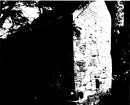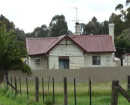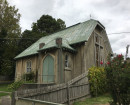ANGLICAN CHURCH
485 RULES ROAD TOORLOO ARM, EAST GIPPSLAND SHIRE
-
Add to tour
You must log in to do that.
-
Share
-
Shortlist place
You must log in to do that.
- Download report
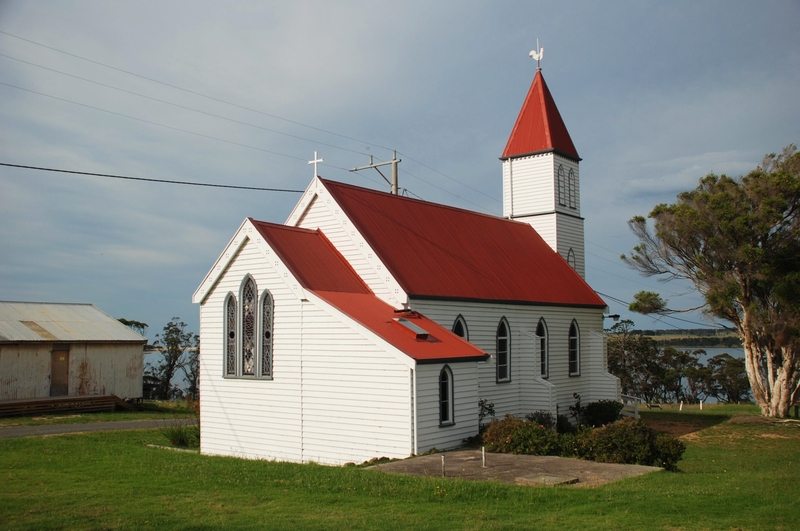

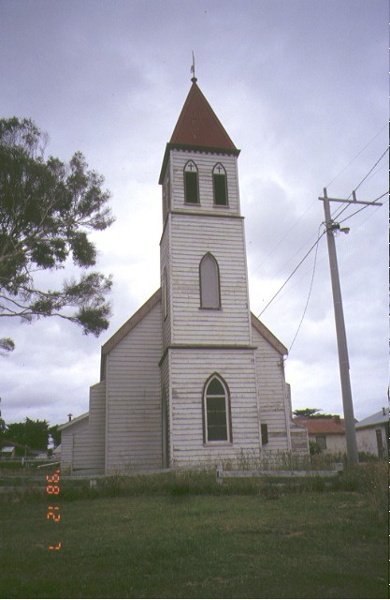
Statement of Significance
The Anglican Church, Lake Tyers Aboriginal Trust, is a timber church constructed in 1878 for the then Lake Tyers Aboriginal Mission to a design by the prominent Melbourne architect, Leonard Terry. Built by Aboriginal labour, it has been the focus of the Aboriginal Mission, architecturally and socially, since its construction.
How is it significant?
The Anglican Church, Lake Tyers Aboriginal Trust, is architecturally, historically and socially significant to the state of Victoria.
Why is it significant?
The Anglican Church, Lake Tyers Aboriginal Trust is architecturally significant as a representative work of the prominent Melbourne architects Leonard Terry. It is unusual in being constructed of timber in 1878 with timber buttresses and a three stage square tower. It is a landmark within the village of the Lake Tyers Aboriginal Trust and can be seen from other vantage points across the Lake.
The Anglican Church, Lake Tyers Aboriginal Trust is historically significant as a rare example of an Aboriginal mission church which was part of the Aboriginal Reserve system used to control the Aboriginal population of Victoria from the 1860s. The church has been associated with worship by Aborigines and mission staff as well as many baptisms, marriages and burials of Aborigines from all over Victoria over the past one hundred and forty years and demonstrates the history of European attempts to convert aborigines to Christian values. In the period from 1886 to 1923 when part-Aborigines were forbidden to come on to the Reserve and to mix with their full-blood relatives, the church was the only permitted meeting place.
The Anglican Church, Lake Tyers Aboriginal Trust, is socially significant because of its association for the Aboriginal community in Victoria as a link with the community's past experience on the Aboriginal reserves.
-
-
ANGLICAN CHURCH - History
Contextual History:
Aboriginal Reserves
In 1860 the Victorian government set up a Board for the Protection of Aborigines. Its new policy was to give land grants for mission stations or reserves for Aborigines. By the end of the 1860s a system of central and outer stations was set up. . The central stations were the four missions at Lake Wellington (Ramahyuck), Lake Tyers, Lake Hindmarsh, and Lake Condah, and the two establishments run by the Board at Coranderrk and Framlingham. The outer stations were scattered throughout the colony and were ration depots usually located on the stations of the local guardian for Aborigines.( M. F. Christie. Aborigines in Colonial Victoria 1835-86. Sydney, Sydney University Press, 1979. P. 170)
Lake Tyers Aboriginal Mission
The Lake Tyers Aboriginal Mission was established in 1862 by Church of England missionary John Bulmer. Born near Sunderland in the north of England in 1833, John Bulmer migrated to Victoria in 1852, arriving in Melbourne in January 1853. He had been apprenticed to a builder and cabinetmaker in England. After a short time on the goldfields, he went to the Yelta Mission on the Murray and worked amongst the Aborigines there for some years.( Victorian Aborigines: John Bulmer’s Recollections 1855-1908. Compiled by Alaistair Campbell. Ed. By Ron Vanderwal. Melbourne, Museum of Victoria, 1994. (Museum of Victoria. Occasional Papers Anthropology & History, No. 1, 1994) P. Xi-xii) In May 1861 Bulmer set off to establish his own mission in Gippsland. He looked for a suitable site for six months, initially settling near Buchan where he planted a crop of potatoes and started to build a house. But he realised it was too far from the food sources of the Aborigines and decided to look for a site nearer their fishing grounds. In late 1861 he accompanied some Aborigines on a fishing expeditions and decided that Lake Tyers would be an ideal site. Forty miles east of Bairnsdale, it was remote from white settlement, making it easier for the inhabitants to keep away from alcohol. The place abounded with fish and game and was one to which some Aborigines attached spiritual significance. It was neutral territory for the Kurnai tribe which lessened the problems caused by intense conflict between different groupings within the Kurnai.
Bulmer and his wife arrived at Lake Tyers to start the mission in January 1862. The station consisted of 2000 acres of third class land, temporarily reserved for the Aborigines in 1863 and a further 2000 acres reserved in 1877. (Mervyn Carter. Acculturation at LakeTyers AboriginalMission station 1862-1913. B.A. (Hons) Thesisi, Department of History, LaTrobe University, 1979. P. 32; Kym Thompson. A History of the Aboriginal People of East Gippsland: A Report prepared for the Land Conservation Council, Victoria. Melbourne, 1985. P. 34 gives 1879 as the date of the extension.) The land was subject to occasional flooding, was unfit for crops and could barely feed one sheep per four acres.
John Bulmer, the founder of the Mission, was relatively successful in managing the mission until his retirement in 1908. His skills as a carpenter were very useful at Lake Tyers where he built a home, church and other structures, assisted by Aborigines.( Victorian Aborigines: John Bulmer’s Recollections 1855-1908. Comp. By Alaistair Campbell. Ed. By Ron Vanderwal. Melbourne, Museum of Victoria, 1994. P. xiii ) He held daily services in the church, bribing the Aborigines to attend by giving them tobacco. Although his attempts to convert his charges were mostly unsuccessful, his own attitudes and care for Aboriginal welfare made him respected and loved by the people on the mission. He encouraged work on the mission, such as crop-growing , but was constantly thwarted by government policy. He learnt Aboriginal languages and took an interest in the customs of the people. His papers record information on the culture of the Ganai or Kurnai people. His attitude to the Aborigines changed over the years, and he was able to reassess his own beliefs in the light of his experience. He encouraged marriage amongst the Lake Tyers people and cared for the welfare of Aboriginal children, improving their nutrition and opposing moves to remove them from their parents. It has been claimed that his actions were in part responsible for the survival of the Victorian Aborigines.( Carter, p.77) His relative success appears to be due to his capacity to base his decisions on a growing knowledge of Aboriginal culture.
By the 1880s, Lake Tyers, like most of the mission stations, resembled a small village with church, school house, manager’s residence, dormitory, kitchen, houses for other white staff and huts for the Aborigines in neat rows. A contemporary noted its picturesque appearance:
This establishment with its pretty church and school on either side of the Superintendent’s house and its two rows of neat cottages is situated in a grassy slope running down to the water’s edge and, as first seen across the lake, is reminiscent of an English village.( Quoted by Gould, p. 48)
The Aboriginal population of Gippsland before European contact was probably about 4000. In 1840 there were perhaps two to three thousand members of the Kurnai tribe in Gippsland, occupying land extending west to east from Cape Liptrap to Cape Everard, with some groups moving north to the Dividing Range in the summer. The people living in the lowland area between the present town of Lakes Entrance and Sydenham Inlet belonged to the Krauatungalung branch of the Kurnai and called the present Lake Tyers Bung-Yarnda. Most of these lived close to the coast where food supplies were plentiful and the climate mild. The lakes could support large numbers supporting themselves by fishing and hunting. By 1850 the Ganai were no longer a threat to the Europeans: they could no longer challenge settlers for their land.(Patrick Morgan. The Settling of Gippsland: A Regional History. Traralgon, Vic., Gippslanf Municipalities association, 1997. P. 59.) It was claimed that by 1860 only 250-300 of the Ganai or Kurnai tribe remained in east Gippsland but this estimate probably did not include those who were living in the mountains. Disease, particularly respiratory disease, was responsible for many deaths. Some were killed in tribal conflicts. Because of intertribal animosities, 250 -300 were divided between Bulmer’s mission at Lake Tyers and the Ramahyuck Mission at Stratford near Sale.
The 1886 so-called “Half-Caste” Act ruled that full-blooded Aborigines would remain on the reserves but that the rest had to leave and find work elsewhere. The idea was that the half-castes would be assimilated into the community and the full bloods would die out. This decision caused much hardship. It broke up families and was bitterly resented by the Aborigines. By 1891 all half-castes had left Lake Tyers.(Carter, p. 72) Those excluded from the reserve came back to camp nearby in order to see their relatives. During the operation of the “Half-Caste” Act, the church was a meeting place where the half-castes could meet their full-blood relatives (Phillip Pepper, quoted by Gould, p. 41)
The administration of Lake Tyers passed from the Anglican Church to the Board for the Protection of Aborigines in 1908 (Thompson, p. 62). From the 1880s, it was decided that all residents from other reserves in western Victoria would be moved to Lake Tyers and Ramahyuck. By 1907, most of the families from Ramahyuck were moved to Lake Tyers (Carter, p. 73). By the early 1920s Aborigines from reserves all over Victoria had been resettled at Lake Tyers (Thompson, p. 62). The decision was made to save money, and was made without any understanding of the nature of the Aboriginal clan system. The amalgamation of a large number of tribal groups led to feuding and conflicts (Carter, p. 73).
Bulmer remained Manager of the mission until 1908, when he was replaced by Captain Howe, but he stayed on the station and continued to conduct services in the church until his death on 13 August 1913, aged 80.
Lake Tyers was the only Victorian mission to survive the 1930s depression. It closed on 24 July 1971 when title to the land passed to the Lake Tyers Aboriginal Trust.ANGLICAN CHURCH - Assessment Against Criteria
a. The historical importance, association with or relationship to Victoria's history of the place or object
The Anglican Church, Lake Tyers Aboriginal Trust is historically significant as a rare example of an Aboriginal mission church which was part of the Aboriginal Reserve system used to control the Aboriginal population of Victoria from the 1860s. The church has been associated with worship by Aborigines and mission staff as well as many baptisms, marriages and burials of Aborigines from all over Victoria over the past one hundred and forty years and demonstrates the history of European attempts to convert Aborigines to Christian values. In the period from 1886 to 1923 when part-Aborigines were forbidden to come on to the Reserve and to mix with their full-blood relatives, the church was the only permitted meeting place.
b. The importance of a place or object in demonstrating rarity or uniqueness
The Anglican Church, Lake Tyers Aboriginal Trust is important as the only church known to survive on an Aboriginal reserve in Victoria, and one which has been in continuous use for religious services since its construction in 1878.
c. The place or object's potential to educate, illustrate or provide further scientific investigation in relation to Victoria's cultural heritage
d. The importance of a place or object in exhibiting the principal characteristics or the representative nature of a place or object as part of a class or type of places or objects
The Anglican Church, Lake Tyers Aboriginal Trust is a representative example of a timber church in the Early English Gothic parish church design adopted by the Anglican Church in Victoria in the later nineteenth century. It is substantially intact internally and externally.
e. The importance of the place or object in exhibiting good design or aesthetic characteristics and/or in exhibiting a richness, diversity or unusual integration of features
The Anglican Church, Lake Tyers Aboriginal Trust is important for its aesthetic characteristics and displays an unusual integration of features. It is architecturally significant as the only known example of this construction type designed by the prominent Melbourne architect Leonard Terry. It is unusual in being constructed of timber with timber buttresses and a three-stage square bell tower.
f. The importance of the place or object in demonstrating or being associated with scientific or technical innovations or achievements
g. The importance of the place or object in demonstrating social or cultural associations
The Anglican Church, Lake Tyers Aboriginal Trust, is socially significant because of its association for the Aboriginal community in Victoria as a link with their past experience on Aboriginal reserves. It is particularly significant in its association with the many groups within the Victorian Aboriginal population who were moved there as a result of government policy in the late nineteenth and twentieth centuries. A place which was intended to impose European religious values on the Aborigines, it is socially significant as a meeting place used by the Lake Tyers residents as a means of maintaining traditional Aboriginal kinship connections.
ANGLICAN CHURCH - Permit Exemptions
General Exemptions:General exemptions apply to all places and objects included in the Victorian Heritage Register (VHR). General exemptions have been designed to allow everyday activities, maintenance and changes to your property, which don’t harm its cultural heritage significance, to proceed without the need to obtain approvals under the Heritage Act 2017.Places of worship: In some circumstances, you can alter a place of worship to accommodate religious practices without a permit, but you must notify the Executive Director of Heritage Victoria before you start the works or activities at least 20 business days before the works or activities are to commence.Subdivision/consolidation: Permit exemptions exist for some subdivisions and consolidations. If the subdivision or consolidation is in accordance with a planning permit granted under Part 4 of the Planning and Environment Act 1987 and the application for the planning permit was referred to the Executive Director of Heritage Victoria as a determining referral authority, a permit is not required.Specific exemptions may also apply to your registered place or object. If applicable, these are listed below. Specific exemptions are tailored to the conservation and management needs of an individual registered place or object and set out works and activities that are exempt from the requirements of a permit. Specific exemptions prevail if they conflict with general exemptions. Find out more about heritage permit exemptions here.Specific Exemptions:General Conditions:
1. All exempted alterations are to be planned and carried out in a manner which prevents damage to the fabric of the registered place or object.
2. Should it become apparent during further inspection or the carrying out of alterations that original or previously hidden or inaccessible details of the place or object are revealed which relate to the significance of the place or object, then the exemption covering such alteration shall cease and the Executive Director shall be notified as soon as possible.
3. If there is a conservation policy and plan approved by the Executive Director, all works shall be in accordance with it.
4. Nothing in this declaration prevents the Executive Director from amending or rescinding all or any of the permit exemptions.
5. Nothing in this declaration exempts owners or their agents from the responsibility to seek relevant planning or building permits from the responsible authority where applicable.
Exterior
* Minor repairs and maintenance which replace like with like.
* Removal of extraneous items such as air conditioners, pipe work, ducting, wiring, antennae, aerials etc, and making good.
* Installation or repair of damp-proofing by either injection method or grouted pocket method.
* Regular garden/yard maintenance.
* Installation, removal or replacement of garden watering systems, provided the installation of the watering systems do not cause short or long term moisture problems to the building.
* Laying, removal or replacement of paving in the gardens and the courtyards.
* Repair, removal or replacement of existing garden/yard structures.
* Repair or replacement of boundary fences and gates with similar to original.
Interior
*Minor repairs and maintenance which replace like with like.
* Removal of paint from originally unpainted or oiled joinery, doors, architraves, skirtings and decorative strapping.
* Installation, removal or replacement of ducted, hydronic or concealed radiant type heating provided that the installation does not damage existing skirtings and architraves and provided that the location of the heating unit is concealed from view.
* Installation, removal or replacement of electrical wiring provided that all new wiring is fully concealed.
* Installation, removal or replacement of smoke detectors.ANGLICAN CHURCH - Permit Exemption Policy
The significance of the Lake Tyers Anglican Church lies principally in the intactness of the building. Changes to this building in particular should be evaluated against its high level of integrity. The fence is not original and an appropriate replacement could be permitted.
-
-
-
-
-
ANGLICAN CHURCH
 Victorian Heritage Register H1796
Victorian Heritage Register H1796 -
LAKE TYERS MISSION
 Victorian Heritage Inventory
Victorian Heritage Inventory
-
177 Fenwick Street
 Yarra City
Yarra City -
19 Cambridge Street
 Yarra City
Yarra City -
2 Derby Street
 Yarra City
Yarra City
-
-






